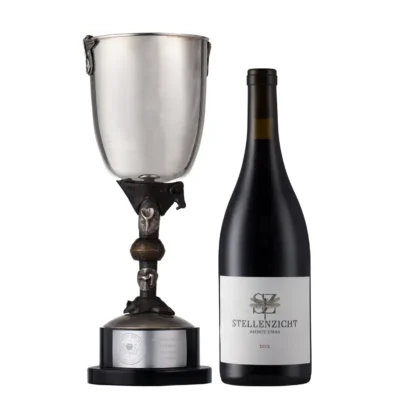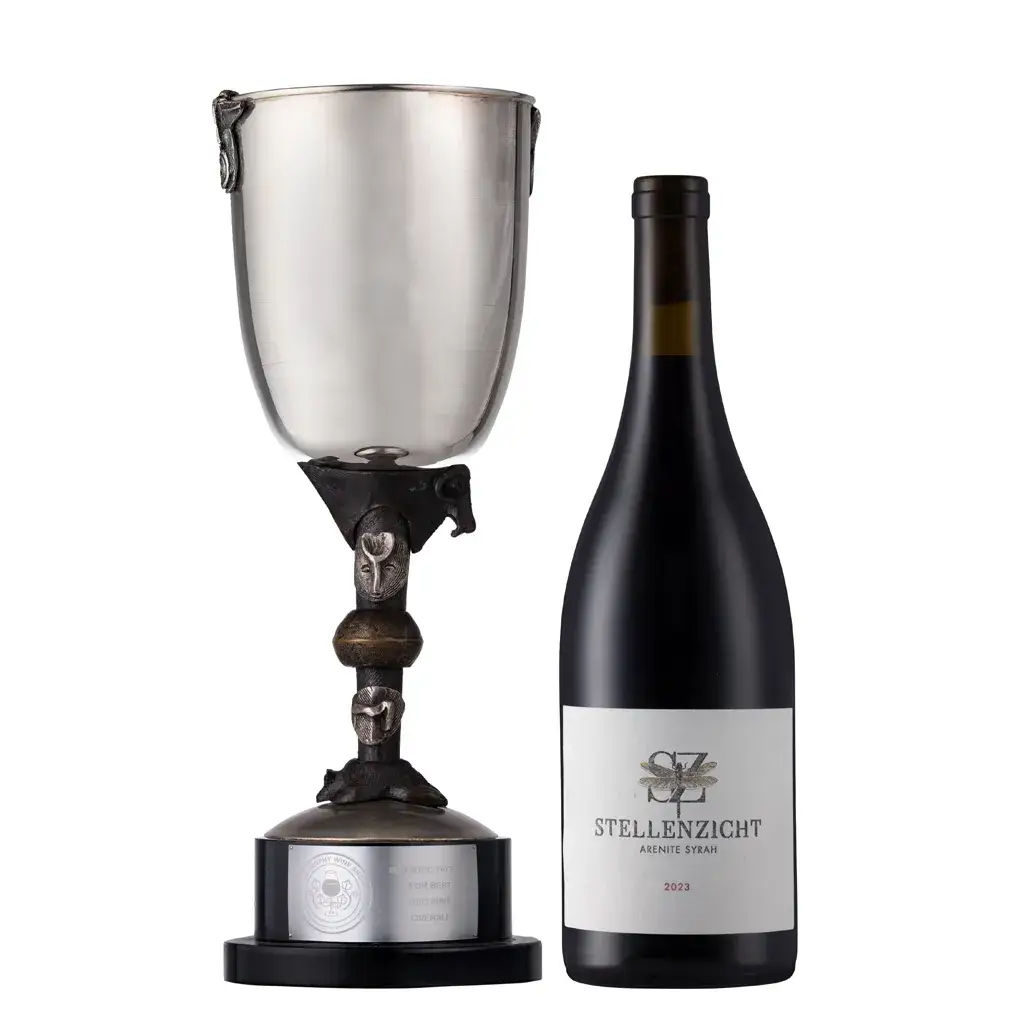 Stellenzicht Arenite Syrah 2023 –
Stellenzicht Arenite Syrah 2023 –
Trophy for Best Shiraz, International Judges’ Trophy (joint winner) and
Trophy for Best Red Wine Overall at the Trophy Wine Show 2025.
At this year’s Trophy Wine Show, 40 of the 650 wines tasted were awarded gold medals. Shiraz led the way with five, the most current-release golds of any category. However, panel chair Tom Carson of Australia noted that as many as 20% of the Shiraz entries showed signs of spoilage yeast Brettanomyces and were deemed faulty.
There is no escaping the reality that South African wine is increasingly polarised. At the top end, a small group – perhaps 50 producers, certainly no more than 100 – both the avant-garde and the historically dominant, continue to pull away from the pack in terms of quality, critical recognition, and pricing power. Meanwhile, the broader base of the industry, some 400 or more producers, struggles for visibility, relevance, and often viability.
This is not a new trend, but it is becoming more pronounced. The top echelon now comprises the likes of Sadie Family Wines, Mullineux, Alheit, Savage, and Rall alongside more traditional stalwarts such as Kanonkop, Meerlust, and Klein Constantia. Add to that some (certainly not all) of the former co-ops now retooled into formidable players in their own right – think Perdeberg, Riebeek Valley Wine Co, and Koelenhof which have all shone in recent Winemag tastings – and it becomes clear that the cream is very much rising. What unites these producers is not scale or style, but the ability to execute consistently at a high level, to innovate when necessary, and to communicate their value both locally and internationally.
But what about the rest? For the bulk of South Africa’s wineries, the playing field has never been level, and it is sloping further still. The proliferation of competitions, guides, and awards means that visibility is increasingly linked to performance in high-profile tastings. The media, this platform included, is often more likely to cover those wines that are already part of the established canon or that break new ground with a compelling backstory or aesthetic. Meanwhile, wines that are merely competent, made without pretension but also without distinction, rarely make headlines.
The market reflects this divide. The top producers are commanding prices that would have seemed impossible a decade ago. De Compostella, Columella, and the like are all now priced in line with fine wine internationally. These are wines made in tiny quantities, yes, but their price tags also reflect growing confidence, global demand, and a belief in the enduring value of South African terroir when interpreted with care. Contrast that with the R60 bottle from an unknown label on a supermarket shelf, and you begin to see the scale of the problem.
Of course, it would be wrong to paint the lower tiers of the industry as entirely stagnant. Many of the former co-ops, once the butt of jokes among the fine wine crowd, are in fact among the most dynamic players at the moment. Consolidated resources, access to significant vineyard holdings, and renewed ambition have enabled some to lift their game dramatically. The quality emerging from DaschBosch in Breedekloof or De Wet Cellar in Worcester, for instance, is often startling. But these successes, while encouraging, are still the exception.
The corporates, meanwhile, remain something of an enigma. Heineken, DGB, KWV, Spier and AdVini are presumably financially sound – but where are the brands that truly capture hearts and minds? Heineken has just completed yet another “reset” of Nederburg, so who knows – maybe this time, it finally shows up to the party. (Credit were credit’s due: Alto‑Ernie Els‑Stellenzicht , owned by German businessman Baron Hans von Staff‑Reitzenstein through his company LVS Capital seem to be getting things right. Locally owned Van Loveren also seems to have big plans.)
So how worried should we be about this polarisation? On one hand, a strong top tier is no bad thing. South African wine needs champions to raise its global profile. The fact that a growing number of local producers can go toe-to-toe with the best in the world is a testament to how far we’ve come. On the other hand, a hollowed-out middle and a struggling base threaten the overall health of the industry.
Wine is an agricultural product, after all. It relies on a functioning ecosystem of growers, workers, cellar hands, and marketers. If only the top 50 producers are thriving, what happens to everyone else? Rural economies, employment, and generational knowledge are all at stake. Moreover, wine drinkers themselves are affected. The full picture of South African wine is not painted solely in grand cru brushstrokes – it includes the everyday, the regional, the honest bottle at a fair price.
There are no easy fixes. Market dynamics favour those with the loudest voices and the deepest pockets. But a more inclusive vision is needed. Regional bodies must continue to elevate local stories. Education and mentorship should be expanded to include marketing and branding, not just vineyard and cellar skills. And critics and journalists must remain open to what is happening beyond the inner circle.
In the end, the top 50 cannot carry the industry alone. They may lead, but if the rest are not at least following in the same direction, the distance between them will only grow. A vibrant wine culture depends on diversity – not just of grape or style, but of producer, place, and perspective.
South African wine has never been better at the top. That’s worth celebrating. But if the industry is to not just survive, but thrive long-term, we must pay closer attention to the base. Some degree of polarisation may be inevitable, but complacency about its consequences is not.

